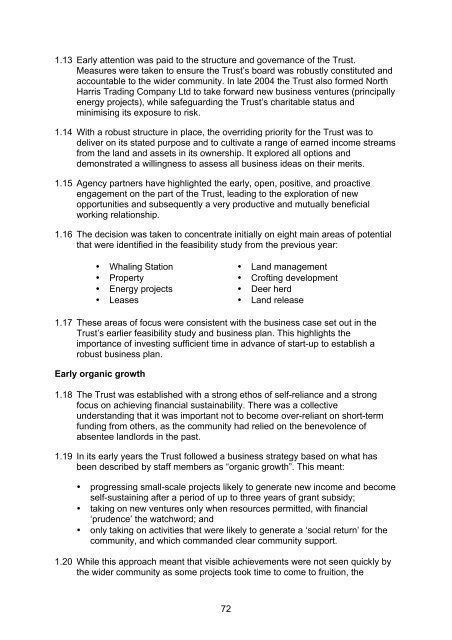Evaluating the Success Factors for Establishing a Thriving - Scottish ...
Evaluating the Success Factors for Establishing a Thriving - Scottish ...
Evaluating the Success Factors for Establishing a Thriving - Scottish ...
Create successful ePaper yourself
Turn your PDF publications into a flip-book with our unique Google optimized e-Paper software.
1.13 Early attention was paid to <strong>the</strong> structure and governance of <strong>the</strong> Trust.<br />
Measures were taken to ensure <strong>the</strong> Trust’s board was robustly constituted and<br />
accountable to <strong>the</strong> wider community. In late 2004 <strong>the</strong> Trust also <strong>for</strong>med North<br />
Harris Trading Company Ltd to take <strong>for</strong>ward new business ventures (principally<br />
energy projects), while safeguarding <strong>the</strong> Trust’s charitable status and<br />
minimising its exposure to risk.<br />
1.14 With a robust structure in place, <strong>the</strong> overriding priority <strong>for</strong> <strong>the</strong> Trust was to<br />
deliver on its stated purpose and to cultivate a range of earned income streams<br />
from <strong>the</strong> land and assets in its ownership. It explored all options and<br />
demonstrated a willingness to assess all business ideas on <strong>the</strong>ir merits.<br />
1.15 Agency partners have highlighted <strong>the</strong> early, open, positive, and proactive<br />
engagement on <strong>the</strong> part of <strong>the</strong> Trust, leading to <strong>the</strong> exploration of new<br />
opportunities and subsequently a very productive and mutually beneficial<br />
working relationship.<br />
1.16 The decision was taken to concentrate initially on eight main areas of potential<br />
that were identified in <strong>the</strong> feasibility study from <strong>the</strong> previous year:<br />
• Whaling Station<br />
• Property<br />
• Energy projects<br />
• Leases<br />
72<br />
• Land management<br />
• Crofting development<br />
• Deer herd<br />
• Land release<br />
1.17 These areas of focus were consistent with <strong>the</strong> business case set out in <strong>the</strong><br />
Trust’s earlier feasibility study and business plan. This highlights <strong>the</strong><br />
importance of investing sufficient time in advance of start-up to establish a<br />
robust business plan.<br />
Early organic growth<br />
1.18 The Trust was established with a strong ethos of self-reliance and a strong<br />
focus on achieving financial sustainability. There was a collective<br />
understanding that it was important not to become over-reliant on short-term<br />
funding from o<strong>the</strong>rs, as <strong>the</strong> community had relied on <strong>the</strong> benevolence of<br />
absentee landlords in <strong>the</strong> past.<br />
1.19 In its early years <strong>the</strong> Trust followed a business strategy based on what has<br />
been described by staff members as “organic growth”. This meant:<br />
• progressing small-scale projects likely to generate new income and become<br />
self-sustaining after a period of up to three years of grant subsidy;<br />
• taking on new ventures only when resources permitted, with financial<br />
‘prudence’ <strong>the</strong> watchword; and<br />
• only taking on activities that were likely to generate a ‘social return’ <strong>for</strong> <strong>the</strong><br />
community, and which commanded clear community support.<br />
1.20 While this approach meant that visible achievements were not seen quickly by<br />
<strong>the</strong> wider community as some projects took time to come to fruition, <strong>the</strong>

















